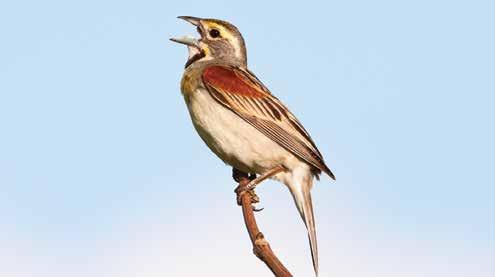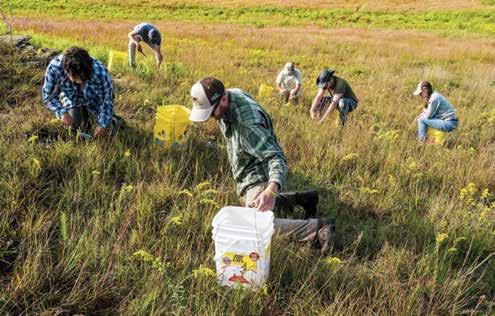
4 minute read
Today’s Inspiration Tomorrow’s Leaders
The Nature Conservancy’s youth programs provide exposure to the real projects and challenges facing global conservation organizations. But many participants discover that the most important skills they gain are building relationships and working within communities.
Critical Thinkers Learn About People and Nature
Advertisement
At TNC’s Indian Boundary Prairies Preserve, TNC’s Youth Environmental Thinkers (Y.E.T.) program, started by its community engagement specialist Debra Williams, provides 16- to 18-year-old interns with an experience that emphasizes and balances the care and value of people and nature. The program’s focus of “Climate Change Environmentally and Sociologically” is defined and applied as the interns are tasked with watching related videos, conducting research and interviews, taking action-oriented field trips and learning fromTNC’s stewardship team.
“I was already interested in environmental concerns but was surprised by what spending time in nature could do for me,” But we especially like to show interns that there are jobs in this field, and in their community, should they wish to continue.”
says Danielle Brogan, a Y.E.T. intern. “I also valued learning how to talk with people and communicate about the natural world.” By the end of the program, interns better understand themselves, how to care for both people and nature and how the environment and people are intertwined.
Teen Stewards Help at Kankakee Sands
At Kankakee Sands Preserve in PembrokeTownship, Illinois, TNC and Pembroke-Hopkins Park Community Development Corporation are continuing a long-term, paid summer intern program started by the U.S. Fish and Wildlife Service. “We host the interns one day a week,” says Rob Littiken, TNC’s Kankakee Sands project director. “They do the necessary but fun work of restoration, like fixing trails and fencing, controlling invasive species and clearing areas for planting.” “We had an intern who is now a pilot, one who is a hip-hop artist and one who wanted to be a veterinarian but now wants to work in conservation,” says Littiken. “We’re thrilled for all of them.
Interns Thrive in a Village in the City
On Chicago’s South Side, the Imani Green Health Advocates (IGHA) program focuses on conservation, spiritual growth and community health outreach. One of the places where they work is Imani Village, a sustainable mixed-use development with which TNC partners in many ways. TNC supports the IGHA program by funding its conservation interns and a fulltime program leader, while also advising on a curriculum around community conservation and local tree plantings. “I was surprised by the interconnections between social wellness and the environment,” says 22-year-old intern Maybelline Mariscal. “Like how having shade at a bus stop or a garden nearby instantly improves people’s emotional and physical health. I wanted to be a police officer but now I’m considering horticulture because I learned that changing the land where you live provides a healthier environment for the whole community.”
full-time scientist. On a cool morning in June, Bach traverses a bumpy path across the prairie in an all-terrain vehicle. She is on her way to a woodland to check on the endangered eastern prairie fringed orchids. Dozens of wild bison graze ahead, the calves nursing and frolicking in the sun. One adult, curved horns protruding from her massive hairy head, greets Bach with a loud, snortlike grunt. “Tallgrass prairie is the most endangered ecosystem in the world,” Bach says. She collaborates with 40 researchers who come to Nachusa to collect data on prairie restoration and preservation. “Their research contributes to our management decisions and impacts ecological practices immediately, not only at Nachusa, but across the country and the globe.” But you don’t have to be a Ph.D. scientist to help Nachusa’s research program. Dozens of adult volunteers serve as community scientists. They monitor dragonflies, conduct frog-call surveys, count birds and orchids and take water samples from streams—all indicators of the ecosystem’s health. They also collect native seeds, remove invasive plants and are docents at the outdoor visitor center. “Volunteers are central to the restoration work we do at Nachusa,” Bach says. Central to these efforts at Nachusa are controlled fires and the reintroduction of wild bison. Indigenous people used fire in the region for thousands of years to regenerate prairie plants for use as medicine and food. New growth, in turn, attracted bison, which were a principal source of food, clothing, and shelter; and key to their spiritual lives. Bison prefer to eat dominant tallgrasses, thus allowing more wildflowers and other grasses to flourish. The prairie, in turn, becomes a healthier and more diverse ecosystem. TNC purchased the initial parcel for the preserve in 1986. “The preserve has since grown to be a model of the harmony and reciprocity that keeps nature in balance. Nachusa is a gift to our children and grandchildren. A place to experience the tallgrass prairie that thrived here for millenia, in this beautiful place that we call the Prairie State,” Bach says. Learn more about this special place and how you can get involved at nature.org/Nachusa.







